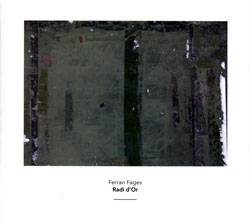
A whistle, a whirr, a low and slowly morphing drone, and this quiet but endlessly fascinating and timbrally jam-packed composition lifts off the ground into an atmosphere of its own making.
The sounds mix, merge and meld together with the softness of what Debussy was loathed to call an "impressionistic" score, but the language is that of European improvisational modernity, to whatever degree Fages' score actually involves improvisation. Timbres take on a level of distinction only to lose it, as can be heard when what sounds like muted kettle drums emerge at around 1:20 only to disappear, unceremoniously, some twenty seconds later. Similarly, is that the quietest possible bowed percussion, courtesy of Pilar Subira, at 12:14, just before Olga Abalos flute and Fages guitar enter in sinewy microtonal counterpoint?
The first fifteen minutes offer up a series of soft-edged fragments, a convergence and divergence of tone and texture that acts as a sort of overture to what follows. The rest of the piece is a continuously evolving wash of multileveled tone, sometimes blending to form the most achingly beautiful sonorities, sometimes traversing and re-traversing the microtonal spectrum. The result is a focused and absolutely meditative journey that places the previous fragments in sharp relief.
As is Another Timbre's wont, this 36-minute tour de force thrives on space and ambience. The soundstage is wide, and open-air listening is especially gratifying. That said, headphones reveal areas of the sonic spectrum, especially in Tom Chant's saxophone overtones and Lali Barriere's sine waves, that may be lost in an open environment. Indeed, the sine waves serve as the glue that holds much of the mixture together, and their range and diversity is nothing short of amazing. In terms of sheer beauty of sound and unity of purpose, this is now one of the best releases in Another Timbre's rapidly growing catalog.
Comments and Feedback:



More Recent Reviews, Articles, and Interviews @ The Squid's Ear...


|

